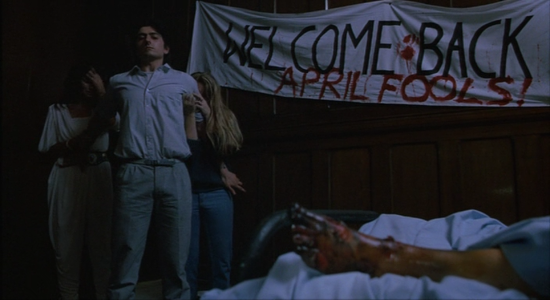
Eaten Alive aka Death Trap (1977)
directed by Tobe Hooper
starring Neville Brand, Robert Englund, Marilyn Burns
Unapologetically gritty and sleazy, Eaten Alive (aka Death Trap) was Tobe Hooper’s follow up to The Texas Chain Saw Massacre. Although he left the film early and did not have any input on the editing process, the tones of a Hooper film are extremely evident: an extremely unhinged villain, an often frantic pace, characters that are driven by instinct rather than logic, and a setting of a seemingly off-the-map, forgotten town. Everything is also accompanied by a very harrowing, chaotic score that is almost simply noise at times. Eaten Alive has a plot that serves as a buffet line for an alligator. Judd (Neville Brand) is the owner of the run-down Starlight Hotel perched just above a pond housing a alligator, who will eat anything that gets near it. It becomes the easy disposal method of the dead bodies that Judd creates, seemingly unable to ever control his anger.

One of the town locals is Buck, played by a young Robert Englund. Well, he’s not too much younger than he was for his debut in the A Nightmare on Elm Street series, but the lack of burn makeup gives him substantial years of youth. He’s an interesting character, the first we see in the movie. He is soliciting a prostitute and his complete sleaziness and desire to sodomize her scares her off. She flees to the Starlight Hotel, where Judd is disgusted by her recognizing her former role at the brothel. Judd also has a hatred for Buck, who is overly sexualized and successful with local loose women. Judd’s sexual frustration is obvious, a common theme in horror movies, but what Eaten Alive does well is contrast it with Judd’s gator whom he claims and almost apologizes for its behavior by saying its only instinct. Pure psychotic behavior seems to be Judd’s instinct, which he is seen fighting at times, but can never stave off. Judd is a villain that an outside eye would call creepy, he is cordial but never able to charm, and someone about him seems off. An outsider, but accepted by the locals of not being too dangerous.
A fantastic scene showing this comes later in the film when Buck is with a young girl in one of the hotel rooms, an older woman he has captured and tied up is moaning and trying to free herself in another, and a young girl hiding from him is occasionally screaming and calling for help below the building. His loud, inner chaos is displayed to audiences by his constant raising of the radio as he paces back and forth, cornered in a bad spot but unable to decide his next move. Hooper always showed strong capabilities of creating a demented villain, and this was definitely one we the madness of saw a little more intimately.

Despite the schlocky nature of the film, Eaten Alive oddly has a little bit of a classical Hollywood flavor to it as a result of it being shot on a soundstage. To soften how obvious this is to the viewer, the lighting is often very colorful and almost over the top draining focus from the painted background walls. Blood red lights often illuminate everything, and a softer green immediately contrasting those shots. The sets are excellently done, with all the locations perfectly displaying a rundown swamp town. All of the locations, a bar, the hotel, brothel, and a one-man sheriff station, are jaded and really give the sense that this small community is from another time. The only effects in the movie that are really poor done are for the gator. The killer, monstrous creature ultimately makes the shark from Jaws look magnificently convincing. However, it’s hidden well for the most part (at least until the later stages of the film) and everything else is effective and gruesome enough it’s not too bothersome.
While Eaten Alive is an extremely interesting film, it definitely could have used a little more polish. Perhaps it did have something to do with Hooper departing the project and the remaining crew not really knowing how to portray the original vision, or just a lack of budget. Some of the cuts in the film are noticeably poor, and while the lighting is rather interesting, at times it’s simply too dark in the wrong places or changes tones at curious, illogical points. While Judd and Buck are two very solid characters, the rest of the cast seems to exist simply to line up as victims (even with Marilyn Burns, who was Sally in The Texas Chain Saw Massacre). The film is also rather well paced for about two-thirds of the runtime, but stutters near the end seeming almost lost as how to wrap things up. Still, an absolutely entertaining film that is absolutely a rough, no holds barred, blood-soaked blast.
7.5














